NCERT Solutions for Ch 4 Animals, Birds, and Dr. Dolittle Class 7 English Poorvi
Book Solutions1
Answer
Example: I have a dog because it is loyal and fun. People spend time with pets by playing, feeding, or walking them. If I don’t have a pet, it might be because of less space or time.
2
Answer
Example: I would speak to a parrot because it is colorful and smart. I want to know what it thinks about flying and living in trees.3
Answer
Example:1. Happy (dog wagging tail)
2. Curious (cat looking up)
3. Angry (bird puffing feathers)
4. Tired (horse with droopy eyes)
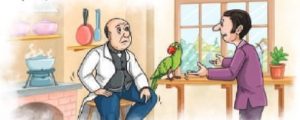
4
1. earns less fee by treating human patients
2. enjoys the company of animals as they speak less
3. dislikes spending time with human patients
4. knows more about animals than the local veterinarians
Answer
4. knows more about animals than the local veterinarians
The Cat's-food-Man says, "you know all about animals—much more than what these vets here do", showing he believes Dolittle is better than local veterinarians.
5
QII: Fill in the blanks by choosing the suitable option given in the brackets.
Doctor Dolittle reacts to Polynesia's information about animal languages with both excitement and ___________ (certainty/curiosity). He rushes to _____________ (write/memorise) the bird words she provides and is interested in learning more.
Answer
excitement and curiosity; write
The story states, "Tell me some more,' said the Doctor, all excited, showing excitement and curiosity. He rushes to get a book and pencil to "write it down," confirming he writes the words.
6
Answer
Yes, Doctor Dolittle would be famous because he can talk to animals and understand their problems, like prescribing glasses for a horse. This makes him unique and effective, attracting many animals.7
1. Humans talking to farm animals
2. Farm animals wearing glasses
3. Farm animals learning bird language
4. Birds riding atop farm animals
Answer
2. Farm animals wearing glasses
The story says, "soon it became a common sight to see farm animals wearing glasses in the countryside, round Puddleby", after Dolittle prescribed glasses for a horse.
8
Answer
• Challenges: Too many animals crowding his garden, difficulty managing time, and different animal needs.• Solutions: He makes special doors for different animals, organises treatment by type, and learns their languages to diagnose quickly.
9

Answer
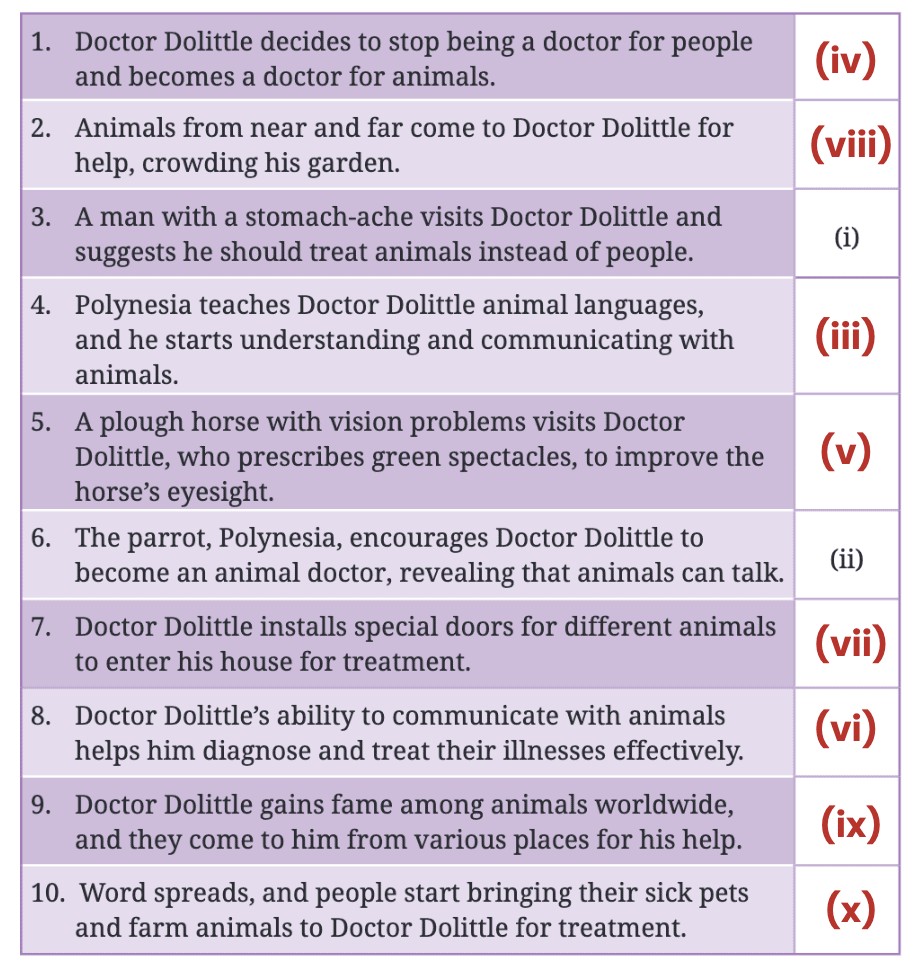
10
I. Read the extracts given below and answer the questions that follow.
1“If I say, ‘Polly wants a cracker’, you understand me. But hear this: Kaka oi-ee, fee-fee?”
“Good Gracious!” cried the Doctor. “What does that mean?”
“That means, ‘Is the porridge hot yet?’—in bird language.”
“My! You don’t say so!” said the Doctor. “You never talked that way to me before.”
“What would have been the good?” said Polynesia, dusting some cracker crumbs off her left wing. “You wouldn’t have understood me if I had.”
(i): Complete the sentence by choosing the correct option. In the line, "Good Gracious!" cried the Doctor, the expression 'Good Gracious' can be replaced by______!
A. bravo
B. gosh
C. alas
D. hurray
(ii): Why had Polynesia never used bird language with the Doctor earlier?
(iii): Identify whether the following statement is true or false. Polynesia had been munching on a food item while talking to Doctor Dolittle.
(iv): How did Doctor Dolittle feel according to the extract?
A. anxious
B. surprised
C. angry
D. relaxed
Answer
(i) B. gosh
"Good Gracious" expresses surprise, as does "gosh." The Doctor is surprised to learn bird language (page 50). "Bravo" (praise), "alas" (sadness), and "hurray" (joy) do not fit.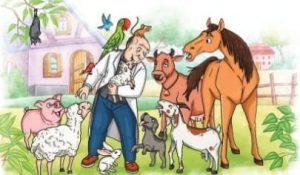
(ii) This is because the Doctor wouldn’t have understood her.
Polynesia says, "You wouldn’t have understood me if I had", as he didn’t know bird language before.
(iii) True
The story mentions Polynesia "dusting some cracker crumbs off her left wing", indicating she was eating crackers.
(iv) B. surprised
The Doctor’s reactions like "Good Gracious!" and "My! You don’t say so!" show he is surprised by Polynesia’s revelation about bird language.
11
2. “I would like a pair like yours,” said the horse—“only green. They’ll keep the Sun out of my eyes while I’m ploughing the field.”
“Certainly,” said the Doctor. “Green ones you shall have.”
“You know, the trouble is, Sir,” said the plough horse as the Doctor opened the front door to let him out—“the trouble is that anybody thinks she can doctor animals— just because the animals don’t complain. As a matter of fact, it takes a much cleverer man to be a really good animal doctor than it does to be a good people’s doctor.”
(i): Choose a word from the extract to complete the analogy. digging: flower bed :: ______ : field
(ii): Choose the correct word to complete the sentence. Doctor Dolittle’s attitude in the extract is
A. respectful
B. sentimental
C. understanding
D. careful
(iii): Complete the sentence with an appropriate reason. Based on the extract, we can conclude that doctors take animals for granted because ________.
(iv): Do you agree with the concluding sentence of the extract? Why/why not?
Answer
(i) ploughing
The horse says, "While I’m ploughing the field". Digging is an action done in a flower bed, and ploughing is an action done in a field.
(ii) C. understanding
The Doctor listens to the horse’s need for glasses and agrees, saying, "Of course—of course", showing he understands the horse’s problem.
(iii) animals don’t complain.
The horse says, "anybody thinks he can doctor animals—just because the animals don’t complain", suggesting doctors assume animals are easy to treat since they don’t speak.
(iv) Yes, I agree because being a good animal doctor requires understanding animal languages and their unique needs, which is harder than treating humans who can explain their symptoms (page 51).
12
QII. Answer the following questions.
1: How can we say that Polynesia was a good trainer of animal language?
Answer
Polynesia was a good trainer because she taught Dolittle bird language patiently, starting with simple words like "Ka-ka oi-ee, fee-fee", and helped him understand animal body language, like Jip’s nose twitch (page 46).13
Answer
He made special doors for different animals (horses, cows, sheep, mice) to organise visits. He listened to each animal’s specific problem, like prescribing green glasses for a horse, ensuring individual care.14
Answer
Dolittle listens to Polynesia’s advice to become an animal doctor and learns animal languages. This shows that considering others’ ideas, even from a parrot, can lead to success, like his fame among animals.15
Answer
1. Communication: He learned animal languages, allowing him to understand their problems.2. Care: He prescribed glasses for a horse, solving its blindness.
3. Organisation: He made special doors for different animals, making treatment easier. These qualities made animals trust him.
16
Answer
People would treat animals better, understanding their needs and pain. Vets would diagnose problems easily, like Dolittle did with the horse. Animals might live happier lives, and humans would respect nature more.17
I. Read the following words from the text.
Cat’s-food-Man, bird language, flowerpots
Are all the words that are combined to form another word written the same way?
Compound words are formed by combining two words of different parts of speech to create a new word that has an entirely new meaning. They are of three types─hyphenated (Cat’s-food-Man), open compound words (bird language) and closed compound words (flowerpots).
Complete the following table correctly by choosing words from the box given below

Answer
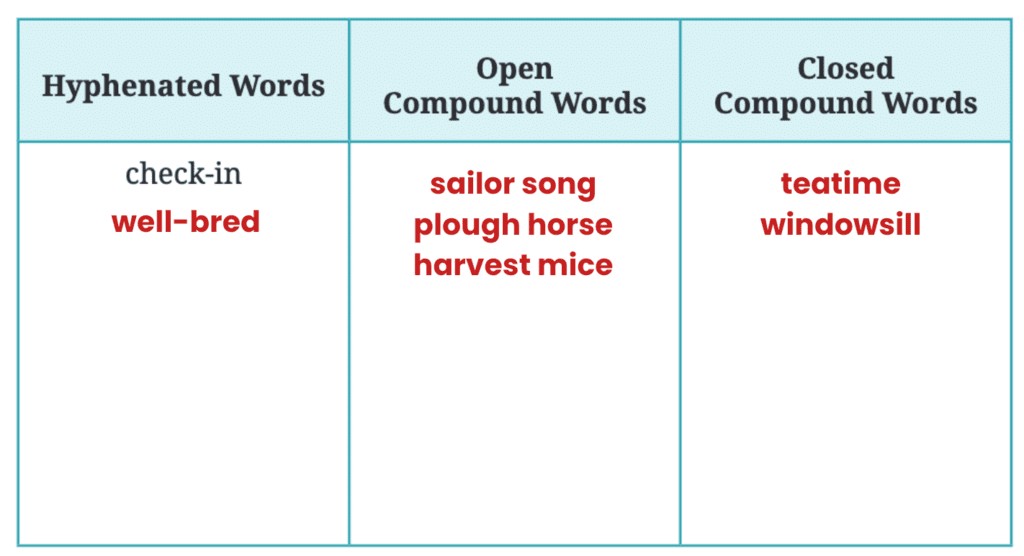
18
QII: Create compound words from the table given below. 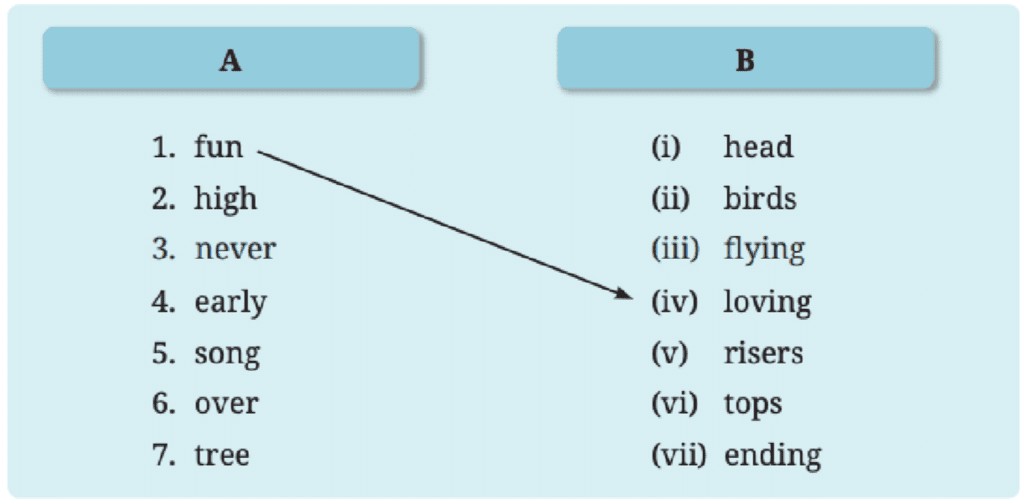
Answer
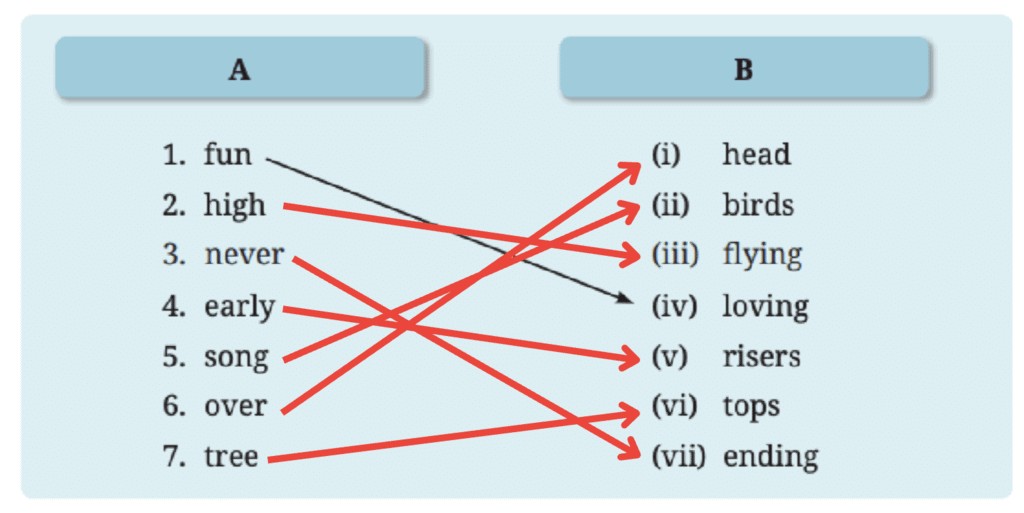
19
Now, complete the paragraph with suitable compound words from the table.
After being treated by Doctor Dolittle, the A. Fun-loving dolphins danced playfully in his sanctuary. The B. _____ chatter of monkeys echoed through the C. _____, their ailments cured. D. _____ eagles soared gracefully E. _____, their health restored. F. _____ among the G. _____, chirped joyfully from the branches. All creatures were happy with Doctor Dolittle’s care.
Answer
After being treated by Doctor Dolittle, the A. fun-loving dolphins danced playfully in his sanctuary. The B. never-ending chatter of monkeys echoed through the C. tree-tops, their ailments cured. D. High-flying eagles soared gracefully E. over-tops, their health restored. F. Song-birds among the G.early-risers, chirped joyfully from the branches. All creatures were happy with Doctor Dolittle’s care.20
1. Dr. Dolittle was eating oatmeal for his breakfast. (a farm animal)
2. Old ladies began to bring him their pets. (an insect)
3. The author sees the connection between humans and animals. (a farm animal)
4. The three baby dinosaurs are from ice age. (field animal)
5. The patients who came late didn’t know where to go. (ship of the desert)
Answer
1. goat2. ant
3. horse
4. mice
5. camel
21
QIV: Read the following sentence from the text. Study the highlighted words.
But that stupid man over the hill never even looked at my eyes.
The highlighted words spell and read the same backwards too.
A word, phrase, or sequence that reads the same backwards as forwards is a palindrome.
Some of the common palindromes include ‘Was it a car or a cat I saw?’, ‘Madam, I’m Adam’ and ‘A man, a plan, a canal—Panama’.
Read the sentences below and identify the palindrome words and sentences.
1. Step on no pets.
2. Naman saw a race car at the show.
3. Nitin speaks in Malayalam.
4. The engineer used a rotator to check the surface level.
5. The pilot relied on the radar to navigate safely.
6. Eva can I see bees in a cave?
Answer
1. Step on no pets.
2. Naman saw a race car at the show.
3. Nitin speaks in Malayalam.
4. The engineer used a rotator to check the surface level.
5. The pilot relied on the radar to navigate safely.
6. Eva can I see bees in a cave?
Now, create your own palindrome.
Ans:
• level
• noon
• radar
• civic
• pop
• wow
• deed
22
QV: Underline the verbs and identify the tense form in the following sentences from the text.
1. He is asking you a question.
2. Oh, there are plenty of animal doctors.
3. I am going blind in one eye.
4. … the trouble is that anybody thinks he can doctor animals.
Answer
1. He is asking you a question. (Present continuous)2. Oh, there are plenty of animal doctors. (Simple present)
3. I am going blind in one eye. (Present continuous)
4. … the trouble is that anybody thinks he can doctor animals. (Simple present)
23
QVI: Read the following sentences from the text.
• That man’s (man has) got sense.
•Can’t you see that it has stopped raining?
In the first sentence the verbs, ‘has got’ denote an action that is relevant at the time of speaking. In the second sentence, the verbs‘has stopped’ denote an action that is recently completed.
We use present perfect tense to indicate:
• a recently completed action
• an action that started in the past and is relevant even at the moment of speaking
• an action in the past where the focus is on the action and not on the time of occurrence (but relevant at the time of speaking)
Structure of Present Perfect Tense:has/ have + V3 (past participle)
Fill in the blanks using the correct form of verbs (present perfect) given within brackets.
Since becoming an animal doctor, Doctor Dolittle 1. _________(learn) to communicate with all animals and birds. He 2. _________ (treat) countless farm animals and pets with care.The parrot, Polynesia, 3. _________ (teach) him bird-language, and he 4. _________ (write) books about his adventures. Many people 5. _________ (bring) their sick animals to his door. Over the years, Dolittle 6. _________ (become) renowned worldwide for his unique abilities.
Answer
1. has learned2. has treated
3. has taught
4. has written
5. have brought
6. has become
24
(I) You will listen to an announcement. As you listen, state whether the following statement is true or false. (Transcript for the teacher on pg. 88)
Statement: Dr. Dolittle’s new clinic presents an offer of free medicines.
Transcript:
Greetings and attention everyone! We are excited to announce the opening of Dr. John Dolittle’s new clinic in the town of Woodstock. The clinic is located at 12, Rose Lane. It will be open Monday to Friday from 9 a.m. to 5 p.m. Special timings for birds are on Saturdays from 11 a.m. to 2 p.m. Dr. Dolittle is renowned for his ability to communicate with animals and shall ensure that they receive the best care possible. All animals are welcome, from horses and cows to pets and wild animals. For the best veterinary care, visit Dr. John Dolittle’s new clinic in Woodstock. Thank you.
Answer
False - The announcement does not mention an offer of free medicines at Dr. Dolittle’s new clinic. It focuses on the clinic’s opening, location, hours, and Dr. Dolittle’s ability to care for animals.25
1. The new clinic is located in the town of ______________.
2. The address is 12, ______________ Lane.
3. The clinic is open Monday to Friday from ______________ a.m. to 5 p.m.
4. Special timings for ______________ are on Saturdays from 11 a.m. to 2 p.m.
5. Dr. Dolittle will ensure that animals get the ______________.
6. All animals—horses, cows, ______________, wild animals, and others are welcome.
Answer
Based on the provided transcript of the announcement, here are the completed details with one or two exact words:1. The new clinic is located in the town of Woodstock.
2. The address is 12, Rose Lane.
3. The clinic is open Monday to Friday from 9 a.m. to 5 p.m.
4. Special timings for birds are on Saturdays from 11 a.m. to 2 p.m.
5. Dr. Dolittle will ensure that animals get the best care.
6. All animals—horses, cows, pets, wild animals, and others are welcome.
26
Conversation between a doctor and a patient
• Read the information about the problems 1–4.
• Use the cue cards provided to guide your conversation.
• Take turns to play parts of doctor and patient.
Problem 1: Cough and cold
• Solution: Ginger and honey mix
• Additional Advice: Drink warm fluids and rest.
Problem 2: Dry lips 
• Solution: Apply ghee
• Additional Advice: Stay hydrated and avoid wetting your lips.
Problem 3: Sore throat 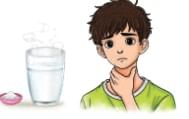
Solution: Gargle with warm salt water.
• Additional Advice: Drink herbal teas and avoid cold drinks.
Problem 4: Fatigue 
• Solution: Ensure adequate sleep and a balanced diet.
• Additional Advice: Take short walks to increase energy levels. 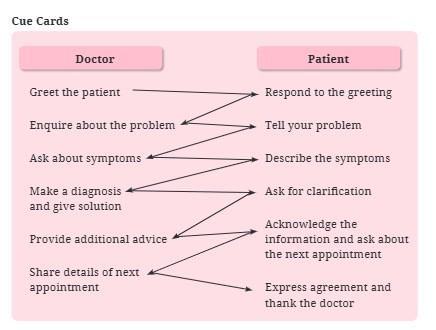
Answer
Below is a sample conversation between a doctor and a patient based on the provided problems and cue cards. The structure is for Problem 1: Cough and Cold, but the format can be adapted for the other problems by substituting the relevant solution and advice. The conversation follows the cue cards for both roles.
• Doctor: Good morning! Welcome to my clinic. How can I assist you today?
• Patient: Good morning, Doctor. I’ve been having a cough and cold for a few days now.
• Doctor: I’m sorry to hear that. Can you describe your symptoms in more detail?
• Patient: Sure. I’ve got a runny nose, a dry cough, and I feel a bit tired. It started about three days ago.
• Doctor: Alright, it sounds like a common cold. I recommend mixing ginger and honey to soothe your cough. Take a teaspoon of this mix twice a day.
• Patient: Ginger and honey? How does that help?
• Doctor: It helps reduce irritation in your throat and boosts your immunity. Additionally, make sure to drink warm fluids, like tea or soup, and get plenty of rest to help your body recover.
• Patient: Okay, that makes sense. Anything else I should know?
• Doctor: Just keep monitoring your symptoms. Let’s schedule a follow-up appointment in a week to ensure you’re feeling better. How about next Tuesday at 10 a.m.?
• Patient: Next Tuesday at 10 a.m. works for me. Thank you, Doctor, I’ll follow your advice.
• Doctor: You’re welcome! Take care and see you next week.
Adapting for Other Problems
To adapt this conversation for Problems 2–4, replace the relevant details:
• Problem 2 (Dry Lips): Diagnosis: “You have dry lips, likely due to dehydration.” Solution: “Apply ghee to your lips twice daily.” Additional Advice: “Stay hydrated and avoid wetting your lips with your tongue.”
• Problem 3 (Sore Throat): Diagnosis: “It sounds like a sore throat, possibly from irritation or infection.” Solution: “Gargle with warm salt water twice a day.” Additional Advice: “Drink herbal teas and avoid cold drinks.”
• Problem 4 (Fatigue): Diagnosis: “You’re experiencing fatigue, possibly due to lack of sleep or poor nutrition.” Solution: “Ensure adequate sleep and eat a balanced diet.” Additional Advice: “Take short walks to boost your energy levels.”
Notes for Enactment
• Role-Playing: Assign one person as the doctor and another as the patient, then switch roles for practice. Use a friendly tone for greetings and a concerned tone when discussing symptoms.
• Cue Card Adherence: Ensure each step (greeting, enquiring, diagnosing, etc.) is covered as per the cue cards.
• Classroom Activity: If in a group, rehearse and perform the dialogue in front of classmates, incorporating gestures like the doctor writing a note or the patient nodding in agreement.
This format ensures a clear, concise conversation that aligns with the activity’s requirements. Let me know if you’d like a specific dialogue for another problem!Below is a sample conversation between a doctor and a patient based on the provided problems and cue cards. The structure is for Problem 1: Cough and Cold, but the format can be adapted for the other problems by substituting the relevant solution and advice. The conversation follows the cue cards for both roles.
• Doctor: Good morning! Welcome to my clinic. How can I assist you today?
• Patient: Good morning, Doctor. I’ve been having a cough and cold for a few days now.
• Doctor: I’m sorry to hear that. Can you describe your symptoms in more detail?
• Patient: Sure. I’ve got a runny nose, a dry cough, and I feel a bit tired. It started about three days ago.
• Doctor: Alright, it sounds like a common cold. I recommend mixing ginger and honey to soothe your cough. Take a teaspoon of this mix twice a day.
• Patient: Ginger and honey? How does that help?
• Doctor: It helps reduce irritation in your throat and boosts your immunity. Additionally, make sure to drink warm fluids, like tea or soup, and get plenty of rest to help your body recover.
• Patient: Okay, that makes sense. Anything else I should know?
• Doctor: Just keep monitoring your symptoms. Let’s schedule a follow-up appointment in a week to ensure you’re feeling better. How about next Tuesday at 10 a.m.?
• Patient: Next Tuesday at 10 a.m. works for me. Thank you, Doctor, I’ll follow your advice.
• Doctor: You’re welcome! Take care and see you next week.
Adapting for Other Problems
To adapt this conversation for Problems 2–4, replace the relevant details:
• Problem 2 (Dry Lips): Diagnosis: “You have dry lips, likely due to dehydration.” Solution: “Apply ghee to your lips twice daily.” Additional Advice: “Stay hydrated and avoid wetting your lips with your tongue.”
• Problem 3 (Sore Throat): Diagnosis: “It sounds like a sore throat, possibly from irritation or infection.” Solution: “Gargle with warm salt water twice a day.” Additional Advice: “Drink herbal teas and avoid cold drinks.”
• Problem 4 (Fatigue): Diagnosis: “You’re experiencing fatigue, possibly due to lack of sleep or poor nutrition.” Solution: “Ensure adequate sleep and eat a balanced diet.” Additional Advice: “Take short walks to boost your energy levels.”
Notes for Enactment
• Role-Playing: Assign one person as the doctor and another as the patient, then switch roles for practice. Use a friendly tone for greetings and a concerned tone when discussing symptoms.
• Cue Card Adherence: Ensure each step (greeting, enquiring, diagnosing, etc.) is covered as per the cue cards.
• Classroom Activity: If in a group, rehearse and perform the dialogue in front of classmates, incorporating gestures like the doctor writing a note or the patient nodding in agreement.
This format ensures a clear, concise conversation that aligns with the activity’s requirements. Let me know if you’d like a specific dialogue for another problem!
27
A notice is a means of formal communication for a particular group ofpersons. It informs them about some important event, such as an invitationto a meeting, an announcement, to give instructions, make appeals, etc.
Write a notice in about 50 words about the Annual Health Check-up forstudents of Grades 6–8. Remind students to collect their health check-upcards from the class teacher. Include all other necessary details about date,time, and venue.
Complete the draft of the notice by using the words and phrases given in the box below.
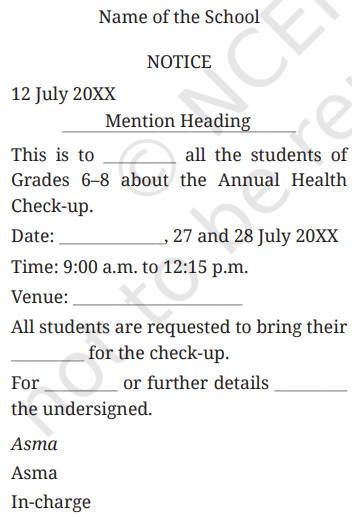
Answer
Name of the SchoolNOTICE
12 July 20XX
Annual Health Check-up
This is to inform all the students of Grades 6-8 about the Annual Health Check-up.
Date: 27 and 28 July 20XX
Time: 9:00 a.m. to 12:15 p.m.
Venue: Assembly hall
All students are requested to bring their health card for the check-up. For queries or further details, please contact the undersigned.
Asma
In-charge
28
(I) The word ‘goshala’ translates to ‘cowshed’ in English. It is a Sanskrit word that is made up of the words ‘go’, which means ‘cow’, and śālā, which means ‘shed’ or ‘hall’.
Plan a visit with the teacher to a ‘goshala’ and find out how the cows are looked after
(II) Ayurveda is the oldest existing medical system in India. Animals received good medicinal care in ancient India. Indian medical treatises like Charaka Samhita, Sushruta Samhita, and Harita Samhita contain references of care of animals. Find out names of different organisations that work for the welfare of animals with the help of the teacher.
(III) What is the best way to take care of stray and abandoned animals?
1. Provide food and water for the animal
2. Take them to an animal shelter
3. Adopt them by taking them home
Give reasons for your responses
Answer
(II) Ayurveda is the oldest medical system in India. It not only helped humans but also cared for animals. Ancient Indian medical books like Charaka Samhita, Sushruta Samhita, and Harita Samhita mention how animals were treated and cared for.
Different organisations working for animal welfare today include:
• People for Animals (PFA)
• Blue Cross of India
• Animal Welfare Board of India (AWBI)
• Society for Prevention of Cruelty to Animals (SPCA)
• WWF India (World Wildlife Fund)
• Humane Society International India
These organisations work to protect animals, provide shelter, medical care, and raise awareness about animal rights.
(III) Best Ways to Take Care of Stray and Abandoned Animals
1. Provide food and water for the animal
• Reason: Stray animals often don’t get enough to eat or drink. Providing food and water helps them survive.
2. Take them to an animal shelter
• Reason: Animal shelters offer safety, medical care, and proper living conditions for abandoned animals.
3. Adopt them by taking them home
• Reason: Adoption gives stray animals a loving and permanent home where they are cared for, protected, and loved.